Anaerobic Bioreduction of Jarosites and Biofilm Formation by a Natural Microbial Consortium
Abstract
1. Introduction
2. Materials and Methods
2.1. Bacterial Cultures and Nutrient Medium
2.2. Preparation of Minerals
2.3. Kinetic Tests
2.4. Ion Chromatography
2.5. X-ray Diffraction Analysis
2.6. Field Emission Scanning Electron Microscopy (FE-SEM)
2.7. Confocal Laser Scanning Microscopy (CLSM)
2.7.1. Nucleic Acid Staining
2.7.2. Lectin Binding Assays
3. Results and Discussion
3.1. Growth of the Natural Consortium
3.2. Bioreduction of Minerals
3.3. Biofilm Formation
4. Conclusions
Supplementary Materials
 ).; Figure S2: Stained denaturing gradient gel electrophoresis (DGGE) gels of bacterial and archaeal 16S rRNA gene fragments amplified by PCR. Numbered DGGE bands correspond to data presented in Table S1; Figure S3: pH and Eh variation during the bioreduction processes: (a) Soluble ferric citrate, (b) potassium and ammonium jarosites, (c) silver jarosite, and (d) gossan mineral; Table S1: DGGE results corresponding to the natural consortium grown on modified Postgate C medium with ferric citrate.
).; Figure S2: Stained denaturing gradient gel electrophoresis (DGGE) gels of bacterial and archaeal 16S rRNA gene fragments amplified by PCR. Numbered DGGE bands correspond to data presented in Table S1; Figure S3: pH and Eh variation during the bioreduction processes: (a) Soluble ferric citrate, (b) potassium and ammonium jarosites, (c) silver jarosite, and (d) gossan mineral; Table S1: DGGE results corresponding to the natural consortium grown on modified Postgate C medium with ferric citrate. Author Contributions
Funding
Conflicts of Interest
References
- Lovley, D.R. Dissimilatory Fe(III) and Mn(IV) reduction. Microbiol. Rev. 1991, 55, 259–287. [Google Scholar] [PubMed]
- Wang, X.-J.; Yang, J.; Chen, X.-P.; Sun, G.-X.; Zhu, Y.-G. Phylogenetic diversity of dissimilatory ferric iron reducers in paddy soil of Hunan, South China. J. Soil. Sediment. 2009, 9, 568–577. [Google Scholar] [CrossRef]
- Jones, E.J.P.; Nadeau, T.-L.; Voytek, M.A.; Landa, E.R. Role of microbial iron reduction in the dissolution of iron hydroxysulfate minerals. J. Geophys. Res. 2006, 111, G01012. [Google Scholar] [CrossRef]
- Bonneville, S.; Behrends, T.; Van Cappellen, P. Solubility and dissimilatory reduction kinetics of iron(III) oxyhydroxides: A linear free energy relationship. Geochim. Cosmochim. Ac. 2009, 73, 5273–5282. [Google Scholar] [CrossRef]
- Berthelin, J.; Ona-Nguema, G.; Stemmler, S.; Quantin, C.; Abdelmoula, M.; Jorand, F. Bioreduction of ferric species and biogenesis of green rusts in soils. C. R. Geosci. 2006, 338, 447–455. [Google Scholar] [CrossRef]
- Dutrizac, J.E.; Jambor, J.L. Jarosites and their application in hydrometallurgy. Rev. Mineral. Geochem. 2000, 40, 405–452. [Google Scholar] [CrossRef]
- Bingjie, O.; Xiancai, L.; Huan, L.; Juan, L.; Tingting, Z.; Xiangyu, Z.; Jianjun, L.; Rucheng, W. Reduction of jarosite by Shewanella oneidensis MR-1 and secondary mineralization. Geochim. Cosmochim. Ac. 2014, 124, 54–71. [Google Scholar] [CrossRef]
- Smeaton, C.M.; Fryer, B.J.; Weisener, C.G. Intracellular precipitation of Pb by Shewanella putrefaciens CN32 during the reductive dissolution of Pb-jarosite. Environ. Sci. Technol. 2009, 43, 8086–8091. [Google Scholar] [CrossRef]
- Weisener, C.G.; Babechuk, M.G.; Fryer, B.J.; Maunder, C. Microbial dissolution of silver jarosite: Examining its trace metal behaviour in reduced environments. Geomicrobiol. J. 2008, 25, 415–424. [Google Scholar] [CrossRef]
- Li, Y.-L.; Vali, H.; Yang, J.; Phelps, T.J.; Zhang, C.L. Reduction of iron oxides enhanced by a sulfate-reducing bacterium and biogenic H2S. Geomicrobiol. J. 2006, 23, 103–117. [Google Scholar] [CrossRef]
- Sheng, G.-P.; Yu, H.-Q.; Li, X.-Y. Extracellular polymeric substances (EPS) of microbial aggregates in biological wastewater treatment systems: A review. Biotechnol. Adv. 2010, 28, 882–894. [Google Scholar] [CrossRef] [PubMed]
- Flemming, H.-C.; Wingender, J.; Szewzyk, U.; Steinberg, P.; Rice, S.A.; Kjelleberg, S. Biofilms: An emergent form of bacterial life. Nat. Rev. Microbiol. 2016, 14, 563–575. [Google Scholar] [CrossRef] [PubMed]
- Karunakaran, E.; Mukherjee, J.; Ramalingam, B.; Biggs, C. “Biofilmology”: A multidisciplinary review of the study of microbial biofilms. Appl. Microbiol. Biotechnol. 2011, 90, 1869–1881. [Google Scholar] [CrossRef] [PubMed]
- González, A.; Bellenberg, S.; Mamani, S.; Ruiz, L.; Echeverría, A.; Soulère, L.; Doutheau, A.; Demergasso, C.; Sand, W.; Queneau, Y.; et al. AHL signaling molecules with a large acyl chain enhance biofilm formation on sulfur and metal sulfides by the bioleaching bacterium Acidithiobacillus ferrooxidans. Appl. Microbiol. Biotechnol. 2013, 97, 3729–3737. [Google Scholar]
- Bellenberg, S.; Leon-Morales, C.-F.; Sand, W.; Vera, M. Visualization of capsular polysaccharide induction in Acidithiobacillus ferrooxidans. Hydrometallurgy 2012, 129–130, 82–89. [Google Scholar] [CrossRef]
- Sánchez, L.; Cruells, M.; Roca, A. Sulphidization-cyanidation of jarosite species: Applicability to the gossan ores of Rio Tinto. Hydrometallurgy 1996, 42, 35–49. [Google Scholar] [CrossRef]
- Viñals, J.; Roca, A.; Cruells, M.; Núñez, C. Characterization and cyanidation of Rio Tinto gossan ores. Can. Metall. Quart. 1995, 34, 115–122. [Google Scholar] [CrossRef]
- Castro, L.; García-Balboa, C.; González, F.; Ballester, A.; Blázquez, M.L.; Muñoz, J.A. Effectiveness of anaerobic iron bio-reduction of jarosite and the influence of humic substances. Hydrometallurgy 2013, 131–132, 29–33. [Google Scholar] [CrossRef]
- Demergasso, C.S.; Galleguillos P, P.A.; Escudero G, L.V.; Zepeda A, V.J.; Castillo, D.; Casamayor, E.O. Molecular characterization of microbial populations in a low-grade copper ore bioleaching test heap. Hydrometallurgy 2005, 80, 241–253. [Google Scholar] [CrossRef]
- Norris, P.R.; Barr, D.W. Growth and iron oxidation by acidophilic moderate thermophiles. FEMS Microbiol. Lett. 1985, 28, 221–224. [Google Scholar] [CrossRef]
- May, A.; Sjoberg, J.J.; Baglin, E.G. Synthetic argentojarosite: Physical properties and thermal behavior. Am. Mineral. 1973, 58, 936–994. [Google Scholar]
- Stookey, L. Ferrozine—A new spectrophotometric reagent for iron. Anal. Chem. 1970, 42, 779–781. [Google Scholar] [CrossRef]
- Lee, J.-H.; Roh, Y.; Kim, K.-W.; Hur, H.-G. Organic acid-dependent iron mineral formation by a newly isolated iron-reducing bacterium, Shewanella sp. HN-41. Geomicrobiol. J. 2007, 24, 31–41. [Google Scholar] [CrossRef]
- Coggon, M.; Becerra, C.A.; Nüsslein, K.; Miller, K.; Yuretich, R.; Ergas, S.J. Bioavailability of jarosite for stimulating acid mine drainage attenuation. Geochim. Cosmochim. Ac. 2012, 78, 65–76. [Google Scholar] [CrossRef]
- Alexandrino, M.; Costa, R.; Canário, A.V.M.; Costa, M.C. Clostridia initiate heavy metal bioremoval in mixed sulfidogenic cultures. Environ. Sci. Technol. 2014, 48, 3378–3385. [Google Scholar] [CrossRef]
- McFaddin, J.F. Biochemical Tests for Identification of Medical Bacteria; The Williams & Wilkins Company: Baltimore, MD, USA, 2000. [Google Scholar]
- Scala, D.J.; Hacherl, E.L.; Cowan, R.; Young, L.Y.; Kosson, D.S. Characterization of Fe(III)-reducing enrichment cultures and isolation of Fe(III)-reducing bacteria from the Savannah River site, South Carolina. Res. Microbiol. 2006, 157, 772–783. [Google Scholar] [CrossRef] [PubMed]
- Salas, E.C.; Berelson, W.M.; Hammond, D.E.; Kampf, A.R.; Nealson, K.H. The impact of bacterial strain on the products of dissimilatory iron reduction. Geochim. Cosmochim. Ac. 2010, 74, 574–583. [Google Scholar] [CrossRef]
- Wakshlak, R.B.-K.; Pedahzur, R.; Avnir, D. Antibacterial activity of silver-killed bacteria: The “zombies” effect. Sci. Rep. UK 2015, 5, 9555. [Google Scholar] [CrossRef]
- Adams, A.P.; Santschi, E.M.; Mellencamp, M.A. Antibacterial properties of a silver chloride-coated nylon wound dressing. Vet. Surg. 1999, 28, 219–225. [Google Scholar] [CrossRef]
- Zachara, J.M.; Kukkadapu, R.K.; Fredrickson, J.K.; Gorby, Y.A.; Smith, S.C. Biomineralization of poorly crystalline Fe(III) oxides by dissimilatory metal reducing bacteria (DMRB). Geomicrobiol. J. 2002, 19, 179–207. [Google Scholar] [CrossRef]
- Sanchez-Andrea, I.; Knittel, K.; Amann, R.; Amils, R.; Sanz, J.L. Quantification of Tinto River sediment microbial communities: Importance of sulfate-reducing bacteria and their role in attenuating acid mine drainage. Appl. Environ. Microbiol. 2012, 78, 4638–4645. [Google Scholar] [CrossRef]
- Pester, M.; Brambilla, E.; Alazard, D.; Rattei, T.; Weinmaier, T.; Han, J.; Lucas, S.; Lapidus, A.; Cheng, J.F.; Goodwin, L.; et al. Complete genome sequences of Desulfosporosinus orientis DSM765T, Desulfosporosinus youngiae DSM17734T, Desulfosporosinus meridiei DSM13257T, and Desulfosporosinus acidiphilus DSM22704T. J. Bacteriol. 2012, 194, 6300–6301. [Google Scholar] [CrossRef] [PubMed]
- Kiran, M.G.; Pakshirajan, K.; Das, G. Heavy metal removal from multicomponent system by sulfate reducing bacteria: Mechanism and cell surface characterization. J. Hazard. Mater. 2017, 324, 62–70. [Google Scholar] [CrossRef]
- Gehrke, T.; Telegdi, J.; Thierry, D.; Sand, W. Importance of extracellular polymeric substances from Thiobacillus ferrooxidans for bioleaching. Appl. Environ. Microbiol. 1998, 64, 2743–2747. [Google Scholar] [PubMed]
- Zhang, R.; Bellenberg, S.; Castro, L.; Neu, T.R.; Sand, W.; Vera, M. Colonization and biofilm formation of the extremely acidophilic archaeon Ferroplasma acidiphilum. Hydrometallurgy 2014, 150, 245–252. [Google Scholar] [CrossRef]
- Zhang, R.Y.; Neu, T.R.; Bellenberg, S.; Kuhlicke, U.; Sand, W.; Vera, M. Use of lectins to in situ visualize glycoconjugates of extracellular polymeric substances in acidophilic archaeal biofilms. Microb. Biotechnol. 2015, 8, 448–461. [Google Scholar] [CrossRef]
- Castro, L.; Zhang, R.; Muñoz, J.A.; González, F.; Blázquez, M.L.; Sand, W.; Ballester, A. Characterization of exopolymeric substances (EPS) produced by Aeromonas hydrophila under reducing conditions. Biofouling 2014, 30, 501–511. [Google Scholar] [CrossRef] [PubMed]
- Zippel, B.; Neu, T.R. Characterization of glycoconjugates of extracellular polymeric substances in Tufa-associated biofilms by using fluorescence lectin-binding analysis. Appl. Environ. Microbiol. 2011, 77, 505–516. [Google Scholar] [CrossRef]
- Karatan, E.; Watnick, P. Signals, regulatory networks, and materials that build and break bacterial biofilms. Microbiol. Mol. Biol. R. 2009, 73, 310–347. [Google Scholar] [CrossRef]
- Colvin, K.M.; Irie, Y.; Tart, C.S.; Urbano, R.; Whitney, J.C.; Ryder, C.; Howell, P.L.; Wozniak, D.J.; Parsek, M.R. The Pel and Psl polysaccharides provide Pseudomonas aeruginosa structural redundancy within the biofilm matrix. Environ. Microbiol. 2012, 14, 1913–1928. [Google Scholar] [CrossRef]
- Flemming, H.-C.; Wingender, J. The biofilm matrix. Nat. Rev. Micro. 2010, 8, 623–633. [Google Scholar] [CrossRef] [PubMed]
- Izano, E.A.; Amarante, M.A.; Kher, W.B.; Kaplan, J.B. Differential roles of poly-N-acetylglucosamine surface polysaccharide and extracellular DNA in Staphylococcus aureus and Staphylococcus epidermidis biofilms. Appl. Environ. Microbiol. 2008, 74, 470–476. [Google Scholar] [CrossRef] [PubMed]
- Clark, M.E.; Edelmann, R.E.; Duley, M.L.; Wall, J.D.; Fields, M.W. Biofilm formation in Desulfovibrio vulgaris Hildenborough is dependent upon protein filaments. Environ. Microbiol. 2007, 9, 2844–2854. [Google Scholar] [CrossRef] [PubMed]
- Neu, T.R.; Lawrence, J.R. Chapter 37—Extracellular polymeric substances in microbial biofilms. In Microbial Glycobiology; Holst, O., Brennan, P.J., von Itzstein, M., Eds.; Academic Press: San Diego, CA, USA, 2010; pp. 733–758. [Google Scholar]

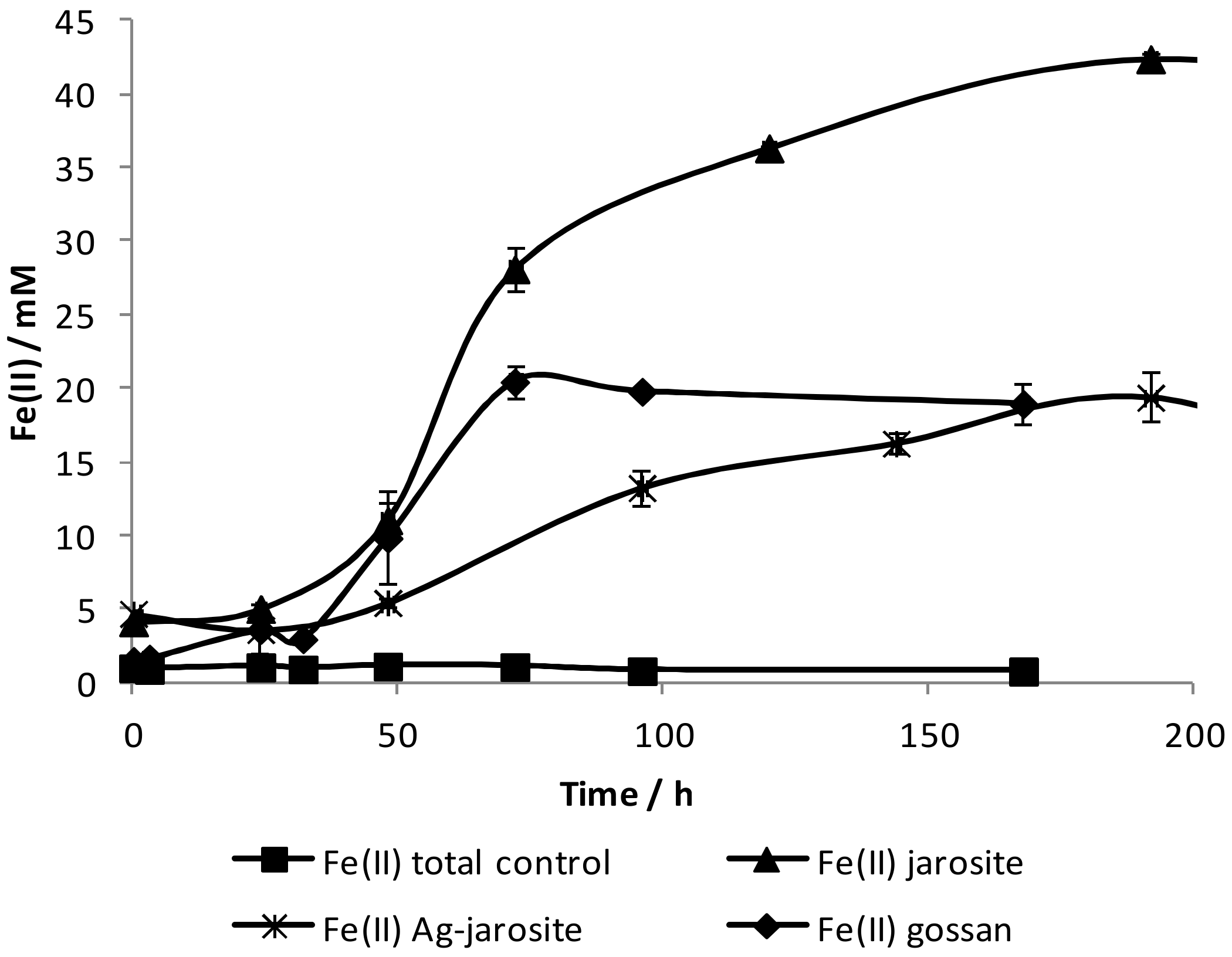
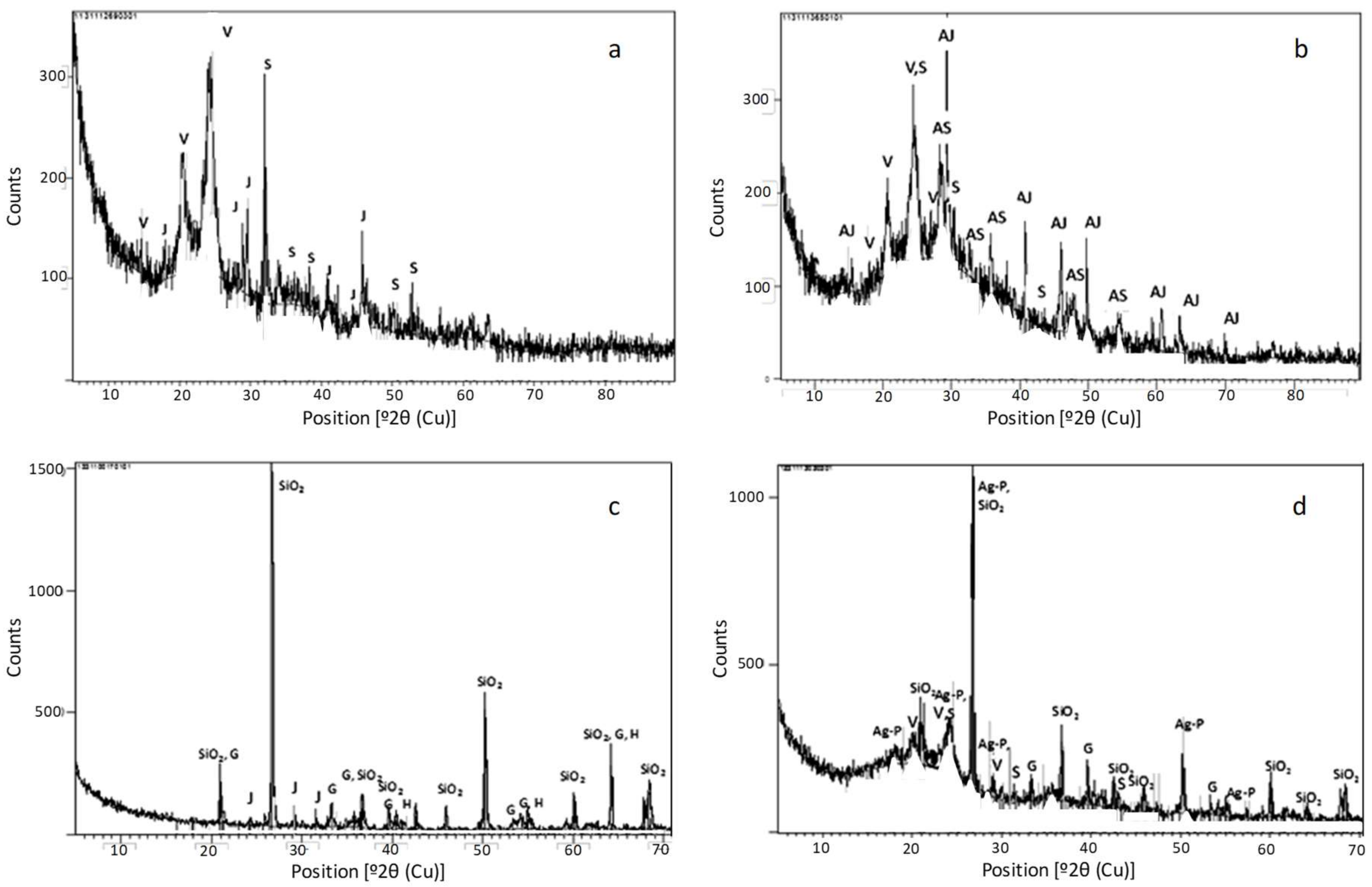
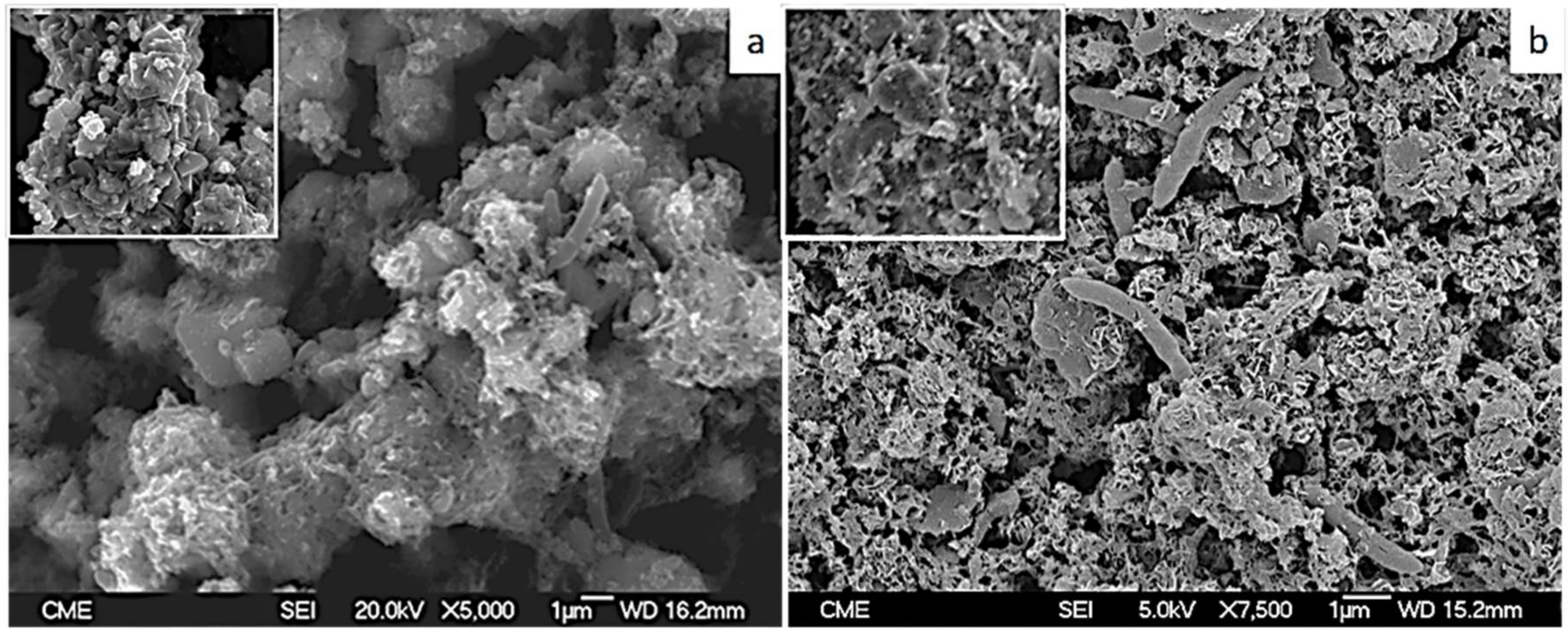
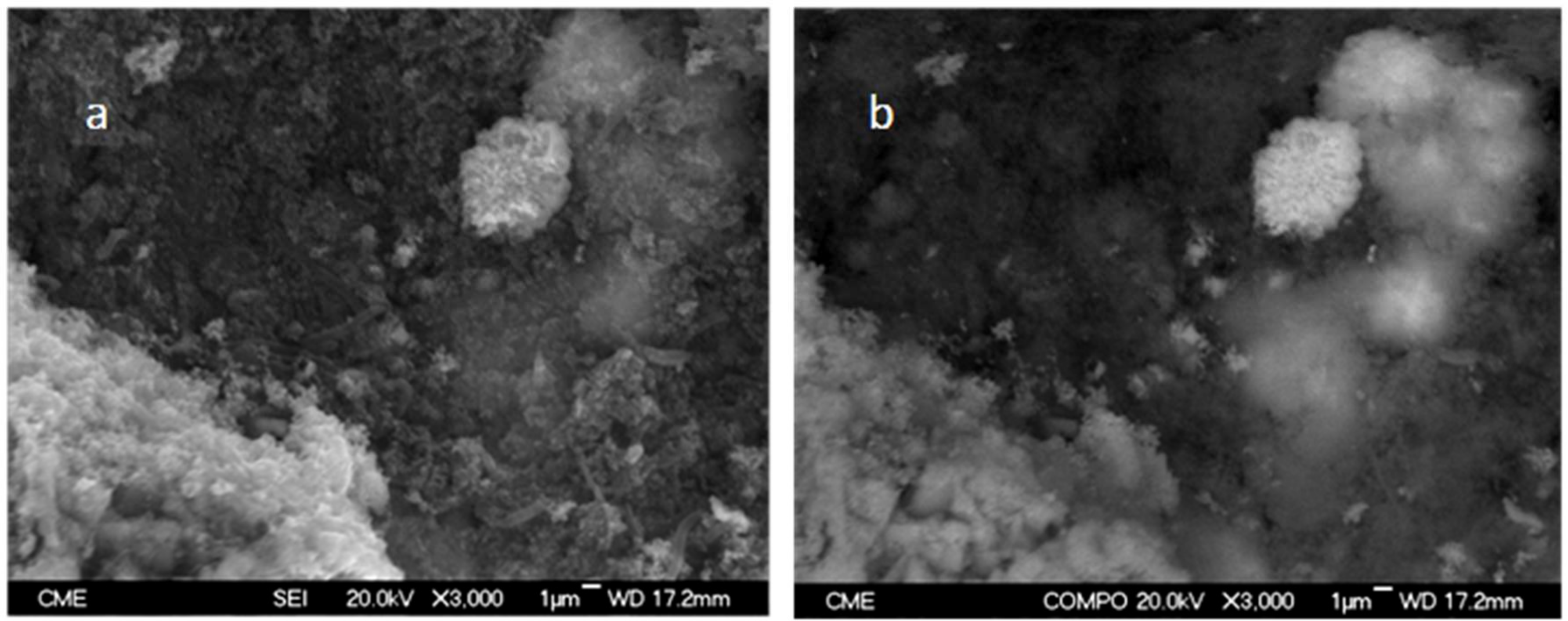
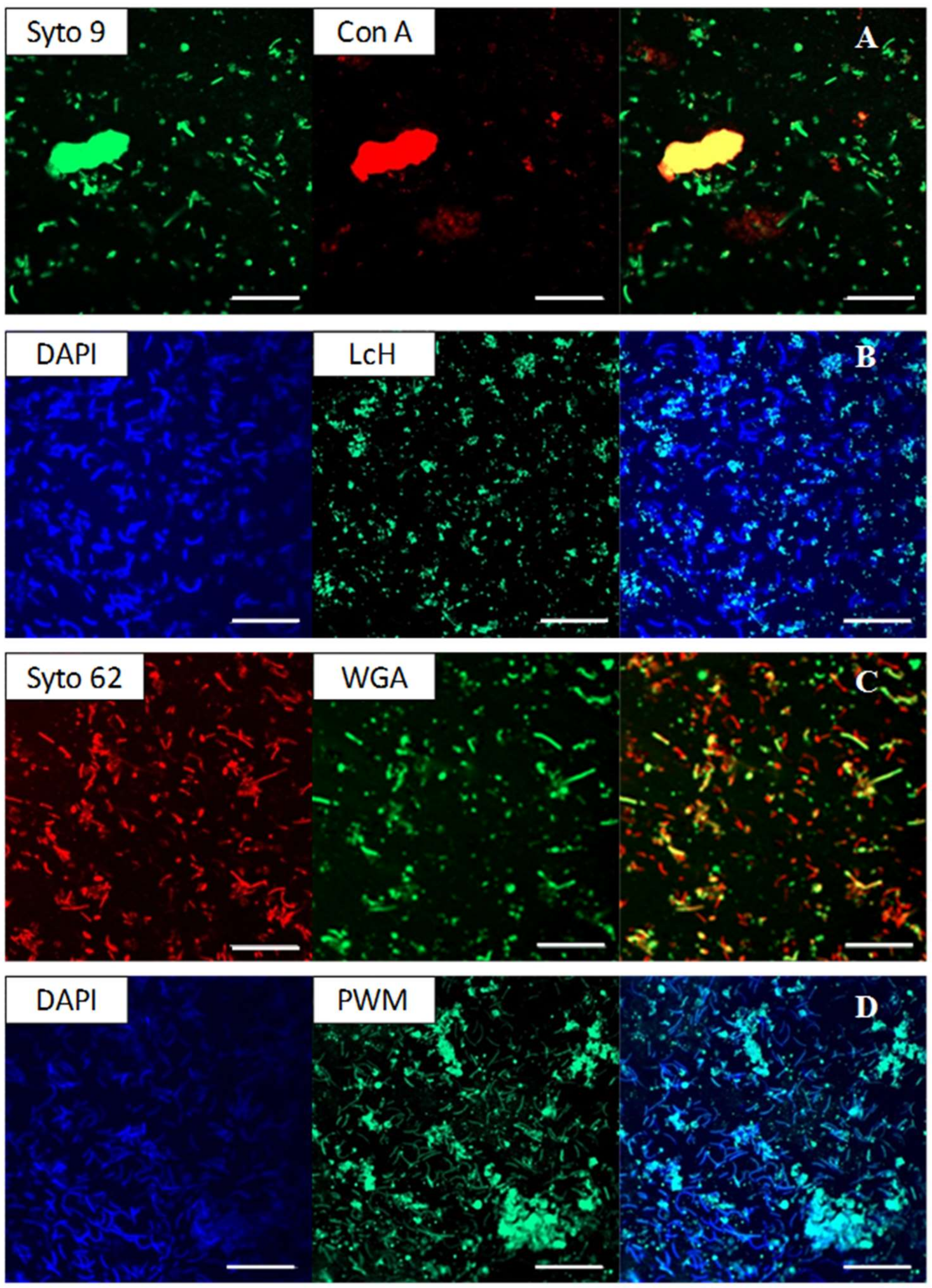
| Lectin | Origin | Label | Specificity |
|---|---|---|---|
| Concanavalin A (Con A) | Canavalia ensiformis | TRITC | α-mannose, α-glucose |
| Peanut agglutinin (PNA) | Arachis hypogaea | FITC | galactose, N-acetylgalactosamine |
| Lens culinaris hemagglutinin (LcH) | Lens culinaris | FITC | α-mannose |
| Wheat germ agglutinin (WGA) | Triticum vulgaris | FITC | N-acetylglucosamine |
| Erythrina cristagalli (ECA) | Erythrina cristagalli | FITC | β-galactose, N-acetylgalactosamine |
| Soybean agglutinin (SBA) | Glycine max | FITC | α- or β-N-acetylgalactosamine |
| Ulex europaeus agglutinin I (UEA I) | Ulex europaeus | FITC | α-1,2 fucose |
| Pokeweed mitogen (PWM) | Phytolacca americana | FITC | N-acetylglucosamine |
| Bandeiraea simplicifolia isolectin (BS I) | Bandeiraea simplicifolia | TRITC | α-d-galactosil or N-acetyl-α-d-galactosaminyl residues |
| Phaseolus vulgaris agglutinin E (PHAE) | Phaseolus vulgaris | FITC | Oligosaccharides |
© 2019 by the authors. Licensee MDPI, Basel, Switzerland. This article is an open access article distributed under the terms and conditions of the Creative Commons Attribution (CC BY) license (http://creativecommons.org/licenses/by/4.0/).
Share and Cite
Castro, L.; Blázquez, M.L.; González, F.; Muñoz, J.A.; Ballester, A. Anaerobic Bioreduction of Jarosites and Biofilm Formation by a Natural Microbial Consortium. Minerals 2019, 9, 81. https://doi.org/10.3390/min9020081
Castro L, Blázquez ML, González F, Muñoz JA, Ballester A. Anaerobic Bioreduction of Jarosites and Biofilm Formation by a Natural Microbial Consortium. Minerals. 2019; 9(2):81. https://doi.org/10.3390/min9020081
Chicago/Turabian StyleCastro, Laura, M. Luisa Blázquez, Felisa González, Jesús A. Muñoz, and Antonio Ballester. 2019. "Anaerobic Bioreduction of Jarosites and Biofilm Formation by a Natural Microbial Consortium" Minerals 9, no. 2: 81. https://doi.org/10.3390/min9020081
APA StyleCastro, L., Blázquez, M. L., González, F., Muñoz, J. A., & Ballester, A. (2019). Anaerobic Bioreduction of Jarosites and Biofilm Formation by a Natural Microbial Consortium. Minerals, 9(2), 81. https://doi.org/10.3390/min9020081






